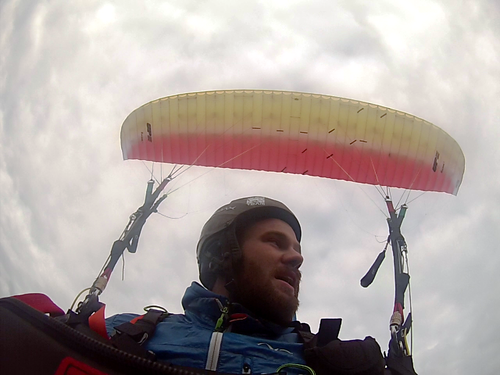UP Ascent 3 M |
|||||||||||||||||||||||||||||||||||||||||||||||||||||||||||||||||||||||||||||||||||||||||||||||||||||||||||||||||||


|
|||||||||||||||||||||||||||||||||||||||||||||||||||||||||||||||||||||||||||||||||||||||||||||||||||||||||||||||||||
Instability rating |
|||||||||||||||||||||||||||||||||||||||||||||||||||||||||||||||||||||||||||||||||||||||||||||||||||||||||||||||||||
|
|||||||||||||||||||||||||||||||||||||||||||||||||||||||||||||||||||||||||||||||||||||||||||||||||||||||||||||||||||
Glider characteristics |
|||||||||||||||||||||||||||||||||||||||||||||||||||||||||||||||||||||||||||||||||||||||||||||||||||||||||||||||||||
|
Launch preparations: easy
launch characteristics: delayed, delayed climb, needs gentle guidance, good feedback during inflation, no braking required, slows before zenith, tends to stall during control check
asymmetric collapse: canopy collapses at low angle to leading edge, en: EinklapperDynamikGering, total course change 90-180°, (1), delayed course change, moderate forward pitching 45-60°, (2), moderate height loss 30-39 m, (2), low sink velocity 10-14 m/s, (1), G-Force < 2,5 G, (1)
Frontal collapse: canopy collapses with low total collapse area, moderate pitch backwards 30-45°, low pitch forwards <30°, low dynamics, no course change, (1), delayed recovery, symmetric recovery, horseshoe, wingtips at front, delayed return to normal airspeed, delayed reinflation of wingtips, moderate height loss 30-39 m, (2), low sink velocity 10-14 m/s, (1)
Spiral dives: moderate sink velocity increase, Low G-Force 3,0- 3,5 G, (1), Sink velocity after 720° <14 m/s, (1), Moderate maximum sink velocity < 18 m/s, (2), sink velocity increase < 6 m/s on brake release, (2), Course change 180-360° after spiral exit, (2), moderate height loss during recovery 30-60 m, (2)
B-Stall: normal force required, moderate pitch backwards 15-30°, moderate pitch forwards 15-30°, stable sink phase, no tendency to deform, immediate return to normal airspeed, 6-8 m/s, height loss on recovery < 20 m
big ears: simple initiation, stable flight phase, delayed automatic recovery, Vsink unaccelerated 2,5-3 m/s, Vsink accelerated 3,5-4 m/s, Vunaccelerated 3-5 km/h less than trimspeed, Vaccelerated 0-3 km/h faster than trimspeed
Steering behaviour: dampened, 75 cm brake travel range, Noticable brake pressure increase, normal stall point, easily identifiable |
|||||||||||||||||||||||||||||||||||||||||||||||||||||||||||||||||||||||||||||||||||||||||||||||||||||||||||||||||||
Notes |
|||||||||||||||||||||||||||||||||||||||||||||||||||||||||||||||||||||||||||||||||||||||||||||||||||||||||||||||||||
|
TakeOff Glider is easy to prepare. The gallerylines have all the some colour, this is a bit difficult for the linecheck. The Riser is very simple and easy to use. The A-Lines and the A-Risers have the same colour. The glider needs support of the pilot after the impuls to climb above him. The glider slows down by itself and needs just a little brakeinput. There is a small tendency, that the glider stays behind the pilot and to stall during the controlphase. Air The glider has a very big weightrange. The testpilots flew the glider in the middle part. It's recommended to fly the glider in the middle and the upper weightrange. The glider feels slow and needs a sensitive pilot on the brakes in turbulent air. The glider should be flown with a good bodyweightshift for steering. The pilot should react sensitive on the brakepressurechange to pretend a stall. Asymmetric Collapse It was hard to make big collapses. The glider shows very less dynamic in pitch and turn. Front Collapse Slow openings in the wingtips. Sometimes the glider made a horseshoe. There was no pilotreaction necessary. Spiral Gliders dives slowly into the spiral and reaches low sinkrates. Most of the time the glider exits very fast. Sometimes it continues turning for 360°. B-Line-Stall Easy BigEars Easy |
|||||||||||||||||||||||||||||||||||||||||||||||||||||||||||||||||||||||||||||||||||||||||||||||||||||||||||||||||||
Rating |
|||||||||||||||||||||||||||||||||||||||||||||||||||||||||||||||||||||||||||||||||||||||||||||||||||||||||||||||||||
|
Safety class 2 This class of paraglider react mildly to all of the following manoeuvres: frontal collapse, asymmetric collapse or spiral dive.Mildly means that the above manoeuvres result in moderately dynamic reactions from the glider and/or moderate height losses. Pilots who have learned and are able to correctly apply basic recovery training techniques should be able to maintain glider control and minimise height loss in the event of one of the above manoeuvres. Generally, subsequent critical glider reactions requiring immediate and precise pilot input are not to be expected from gliders of this class. The safe use of a glider in this class requires skills learnt in standard basic training. Emergency descent methods may be performed with standard techniques and do not require special skills. As on occasion, all gliders may react more dynamically to a disturbance than expected, additional training such as regular ground handling or SIV training is recommended. |
|||||||||||||||||||||||||||||||||||||||||||||||||||||||||||||||||||||||||||||||||||||||||||||||||||||||||||||||||||

